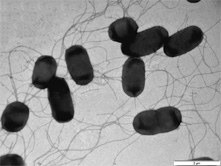| |

Negatively stained electron micrograph of Exiguobacterium sp. strain AT1b grown in TSB at 37 degrees C. (photo provided by Debora Frigi Rodrigues and Alicia Pastor-Lecha)
|
Exiguobacterium strain AT1b was isolated in 2004 by Robert F. Ramaley (Nebraska Medical Center, Omaha, NE), with the assistance of Christie Hendrix (Yellowstone National Park). The strain AT1b was obtained from a slightly alkaline and highly carbonate hot spring water of Angel Terrace, which is part of Mammoth Terrace, Yellowstone National Park.
The nearest phylogenetic neighbors to the isolate AT1b are other hot springs and marine isolates. Strain AT1b groups closely with the type strain Exiguobacterium aurantiacum (DSM 6208), isolated from alkaline effluent of potato was Exiguobacterium AT1b is a non-spore forming Gram positive, catalase positive, nuclease active bacterium. The cells grown at 50oC are rods about 2 um in length, with rounded ends. They occur singly, in pairs or infrequently in chains. Colonies appear orange on TSA media pH 8.8, and the pigment does not diffuse into the medium. They are facultative anaerobes but grow more profusely aerobically.
This strain was chosen for sequencing based on its ability to grow from 15 to 50oC, high nuclease activity, low DNA-DNA hybridization with Exiguobacterium 255-15 sequenced by JGI (http://genome.ornl.gov/microbial/exig/), metabolization of cellulosic materials and carbon cycling in hot environments.
Through comparative genomic analysis, the differences between thermophilic (Exiguobacterium sp. AT1b) and psychroactive (Exiguobacterium sibiricum strain 255-15) strains can be studied. Through analysis of the transcriptome, experiments can be designed to study microbial survival under a variety of high temperature and low temperature conditions. The issue of adaptations to different temperatures is of interest in the field of astrobiology. Organisms that inhabit such diametrally opposite environments may be used as models for understanding cellular responses on astral bodies.
|

